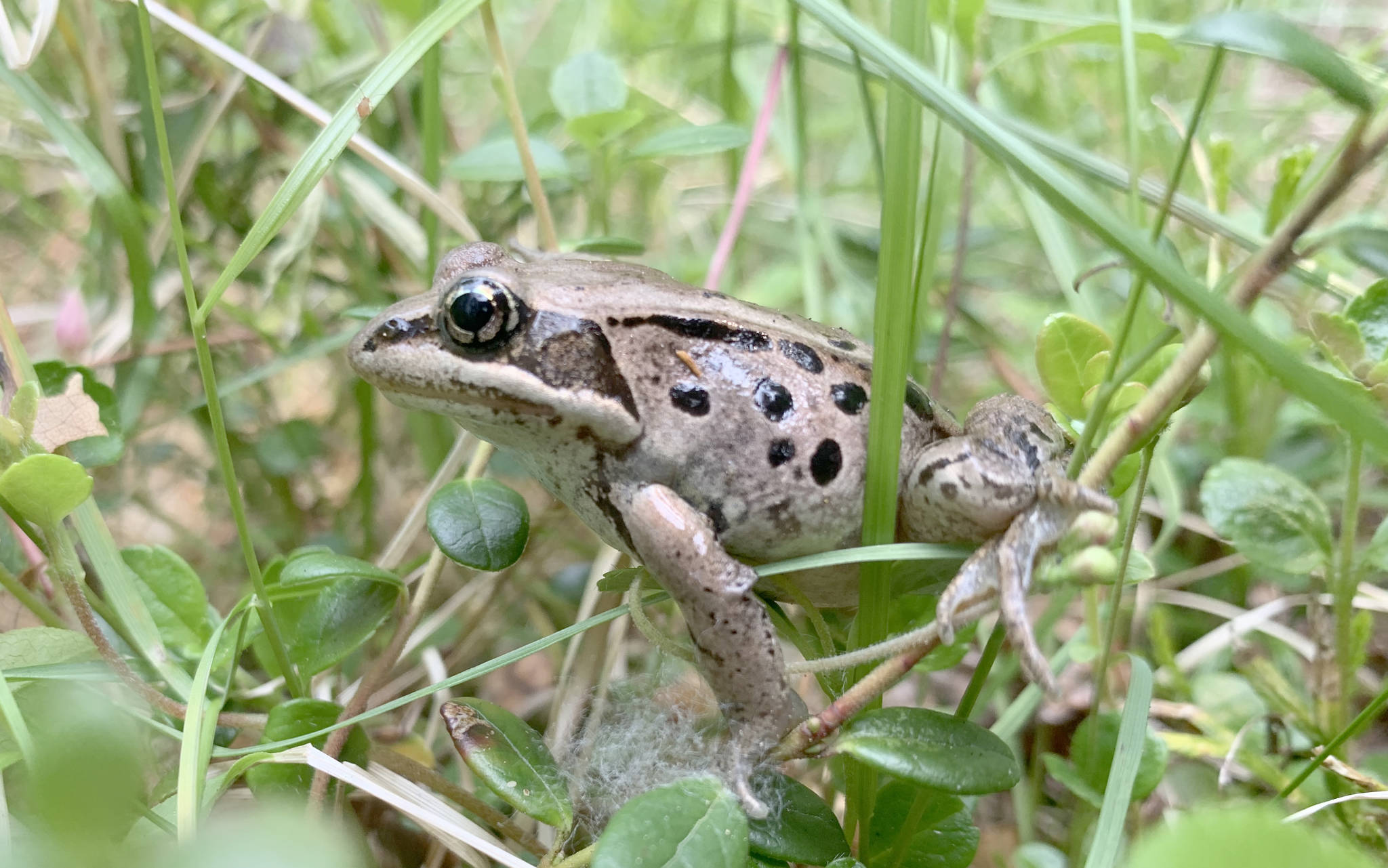I was surprised to learn that despite the diverse wildlife in Alaska, the state has not a single reptile. Alaska’s cold conditions make life in the winter hard to get through. It takes innovative behavior and physiology to manage such an extreme climate.
However, there is one animal, the closest thing we have to a reptile, which has adapted in unique ways: the wood frog.
This small frog is the Kenai Peninsula’s only amphibian! Amphibians need a moist environment to survive, dependent on their very thin skin to absorb water and oxygen. Once winter strikes, water in the soil, lakes and vegetation freezes.
How then, do wood frogs survive through this incessantly dry and frozen season?
Similar to some other species in winter, wood frogs become dormant. The difference is their heart and breathing quite literally stop.
As temperatures decline, wood frogs find a comfortable spot in the duff to bury themselves for the winter. Snow offers some insulation but temperatures often remain subfreezing.
If frogs froze completely, the water inside them would crystalize and draw out the water from inside their cells, causing complete dehydration and death. To avoid this, wood frogs produce glucose that acts as a form of antifreeze.
As the ice in their blood freezes, their liver sends glucose to the cells to bind the water molecules, leaving the cells full of a sugary liquid.
In other words, the water freezes all around the cells but the cells themselves remain unfrozen, keeping the frogs alive. The frogs exist in this state until spring when they thaw out and hop back in the ponds to reproduce. With this adaptation, wood frogs can endure temperatures down to minus 4!
You’d think that a species which can endure such variable climates would have no issue with our warming world, right? Nonetheless, we are seeing anthropogenic effects on this tough little creature.
Mari Reeves, a U.S. Fish and Wildlife Service biologist, studied wood frog abnormalities on five National Wildlife Refuges in Alaska, including the Kenai refuge, from 2004 to 2006.
Prevalence of skeletal and eye abnormalities ranged from 1.5 to 7.9 percent and even reached 20 percent at individual breeding sites. For comparison, background levels elsewhere in North America are typically 1 to 3 percent.
The most common abnormalities were ectromelia (partial limb), micromelia (shrunken limb), amelia (limb missing) and unpigmented iris (eye totally black). In this study, skeletal abnormalities were primarily caused by dragonflies eating the limbs off metamorphosing tadpoles, resulting in lost or stunted development.
However, it’s not quite that simple. Dr. Reeves and her team saw a correlation between road proximity and skeletal abnormalities.
Roads carry all sorts of foreign elements, including heavy metals and hydrocarbon derivatives. These contaminants, along with other abiotic conditions like higher temperatures, can affect the metamorphic development of wood frogs — slowing them down and restricting full developmental potential.
This leaves the frogs smaller, less fit and more vulnerable to predation. Sure enough, the study showed that smaller frogs had more abnormalities than larger ones.
Once mature, wood frogs can become infected by Batrachochytrium dendrobatidis, a fungal pathogen that causes Chytridiomycosis. This disease has been linked to dramatic population declines and extinctions in 30 percent of amphibian species elsewhere in the world.
Chytrid fungus unbinds the proteins in the outer layers of the skin that contain keratin, which allows the fungus to feast on the now-freed amino acids.
The frogs become lethargic during infection and it may cause them to shed their skin. The skin may also grow thick. These attacks on the skin hinder the frogs from breathing, hydrating, osmoregulating or thermoregulating.
In 2002, Reeves discovered a dead wood frog with Chytridiomycosis on the Kenai refuge — the first discovery of Batrachochytrium dendrobatidis in Alaska. Chytrid fungus has since been detected elsewhere in Alaska, mostly along gravel roads and human access sites.
However, abnormalities and Chytrid fungus aren’t the only impacts we’re having on wood frogs. Climate change causes weather and temperatures to vary greatly.
Once the fungus is on frogs, it surprisingly thrives in variable temperatures. This is because the fungus, as a simpler organism, is able to adapt faster than frogs.
Studies have found alterations in frogs’ white (immune) cells due to temperature changes. In other words, climate change is fostering an environment that weakens the frog’s immune systems and makes them more susceptible to this lethal fungus.
Wood frogs showcase how even a robust species remains susceptible to human actions in harmful and unexpected ways. Contaminants leave tadpoles vulnerable to dragonfly predation and mature frogs vulnerable to fungal attacks amplified by human-driven climate change. Their increasing loss of “arms” and legs is an indicator of an ecological system under stress.
Frances Nelson is a biological intern at Kenai National Wildlife Refuge this summer. She is also a junior in Environmental Science at Colorado College. Find more Refuge Notebook articles (1999–present) at https://www.fws.gov/refuge/

